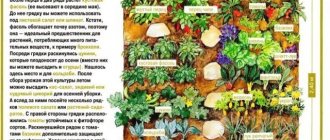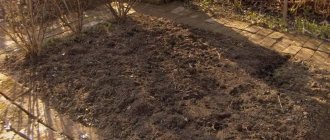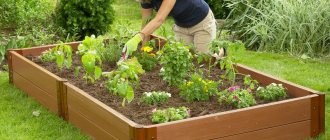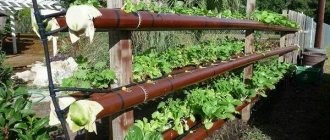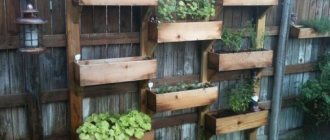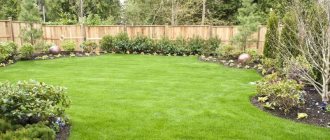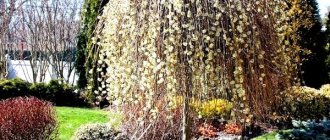Location of beds
To reap a rich harvest at the dacha, you need to choose the right place for future beds. This is of no small importance.
To choose the right place for future beds, inspect the territory of the dacha in the morning and evening. Places where the sun warms the earth will be the best for locating the beds. But there are crops that grow better in the shady part.
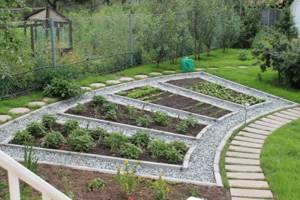
Try to consider some points when arranging your beds:
- It is better to place low plants towards the south side;
- try not to make a bed in the lowlands of the site, as moisture will accumulate there, which will negatively affect the crops;
- when the soil slopes, it is recommended to make an embankment and level all the holes;
- make the beds the same length, it will look aesthetically pleasing and neat;
- To provide one family with supplies for the winter, two acres of fertile soil is enough.
Determining cardinal directions on the site

Before planning the location of the beds, you need to determine the cardinal directions on the site - where are the south, north, east and west. Although this division is conditional, because the southernmost part of the garden will be in contact with the northernmost part of the neighbor’s garden.
It is much more important to calculate how much light each individual section of the garden receives during the day, and to take into account possible shadows from trees and buildings.
It is better to plant sun-loving plants in an area that is in the sun for the maximum time during the day. This is usually the southern part of the site, unless it is shaded by trees and buildings. Shade-tolerant plants can be planted in places shaded by trees and low buildings.
Ideas for creating beds
To people far from the dacha world, it probably seems that the beds differ only in length and height. But this is far from true.

Summer residents use various methods and materials to organize and plant crops in their gardens. The beds can be located both horizontally and vertically. It all depends on the type of crops and the rules for caring for them.

The materials and ideas that are used to design beds are very diverse:
- wood, the most common material. It does not require special care, but must be varnished to increase its service life;
- stone, a very expensive material, but one of the most durable. With its help, you can dream up the shapes of future beds;
- metal, this material is perfect for a frame. But keep in mind that metal is susceptible to rust and rapid heating;
- plastic, the cheapest option for designing a garden bed. Plastic is often used in the design of flower beds and flower beds. But the service life is not very durable;
- improvised materials. Many people use non-standard materials to decorate their beds: car tires, plastic bottles or unnecessary flower pots.
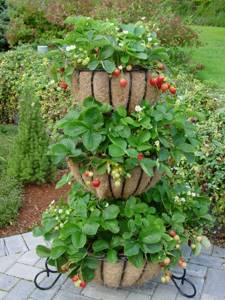
Types of beds
The variety of species will allow both a beginner and an experienced summer resident to make and decorate a garden bed according to their preferences and tastes.
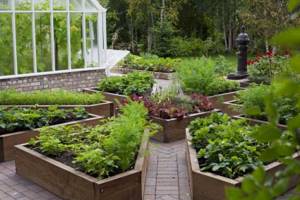
Bed box The most popular and convenient way to arrange a summer house. Making such a bed is not difficult. For production you need boards or slate, plastic and other materials.

Garden bed with drainage. These types of beds are made if the planting site is located in a lowland. After all, excess moisture can lead to rotting of the root system and the death of the plant. For drainage I use sand, sawdust and humus, which are laid alternately, and then a layer of soil is poured.

High beds. Such beds will also provide a kind of drainage. The height of such beds can range from 30 to 80 centimeters.
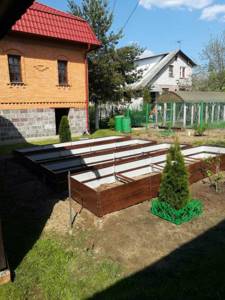
Vertical beds. This method helps to save enough space. To make this type of beds, boxes, containers or racks are useful.
But it should be noted that not all crops are suitable for planting in this way. Plant only crops with a not very developed root system in vertical beds.
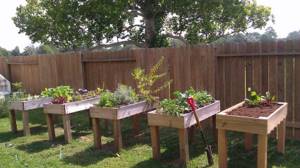
French beds. The shape of the beds is very popular due to its smooth shape and clear delineation of planting crops. A mandatory rule is the presence of paths between plantings, and fences can be made of various materials.
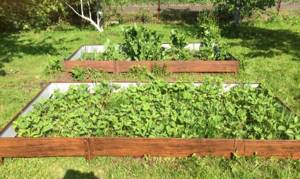
We recommend watching

Types of garden sculptures - original decorative sculptures for a summer cottage and garden (85 photos)

Ideas and tips for a dacha - original solutions for designing and decorating a dacha and house area with your own hands (100 photos)

How to make sliding gates - diagrams, drawings, projects and step-by-step description of installation with your own hands (90 photos and videos)
English beds. Such beds are very original in design. There are no clear boundaries or contours. The beds can be arranged in a chaotic manner, but at the same time they represent a single landscape design.
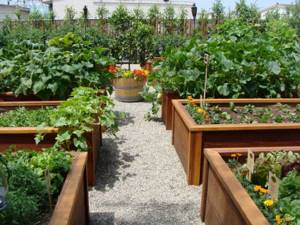
Lazy or beginner beds. Such beds do not require any effort or materials. It is enough to dig up the soil, pick out all the weeds, level it and you can plant the seedlings.

Smart beds. These types of beds are not easy to make, but they are very high quality and practical. As a rule, in such beds the crop productivity is several times greater than in ordinary beds.
Planning crop placement
Determination of soil acidity and adaptation of its composition to the crops grown
To plan planting rationally, it is necessary to study the composition of the soil on the site and find out which plants it is suitable for. It is advisable to determine the acidity of the soil in the laboratory by taking samples from different places on the site. It is also possible to carry out a test at home, but it will not be as accurate: soil samples are poured into a container and a little vinegar is added to them. If bubbles appear on the surface, this indicates a neutral or alkaline soil pH, and a lack of reaction means that the soil is too acidic. Heavy, clayey soil needs to be dug up with sand, peat and black soil. The percentage of additives depends on what crops you intend to grow.

In the photo: Testing soil acidity
How to apply geographical feasibility in planning
When planning beds, you need to take into account the location of the site. On slopes it is best to place transverse beds directed to the south and southeast. In the lowlands, the beds are formed from south to north: this way they warm up faster. On dry soil with deep groundwater, plantings are located from west to east. In this case, the shade from the plants will retain moisture in the soil longer. On a large area, it is advisable to place the vegetable garden in the south, and the orchard in the north. If there are trees on the site, the beds are laid out at some distance from them so that the vegetables do not end up in the shade.
- Turmeric: cultivation, properties and applications

In the photo: Building beds in the yard
Creating beds
The number of beds is planned in accordance with the vegetables being planted. Their width should not be more than 1.2 m, but the narrower the beds, the easier it is to care for them - planting, weeding and watering. The row spacing is left 0.5 m wide so that it is convenient to walk between the beds, pick berries and fruits and remove garbage in the fall. The aesthetic appearance of a vegetable garden depends on maintaining clear boundaries between the beds. To prevent the growth of weeds, the passages are sprinkled with gravel or coarse tree bark.

In the photo: Decorating the beds
The bed itself can be edged with a low border of parsley, lettuce or lovage. Borders should not block plants from light. Their goal is to emphasize beauty and save usable space. To enclose the entire garden, a fence is most often used, but it is better to plant fruit and berry or ornamental shrubs instead - barberry, gooseberries, grapes, cotoneaster, lilac or spirea.
Bulk beds
These beds are raised above the soil level, so they warm up faster in the sun. In regions with cool climates, this advantage is especially valuable. It is good to create such beds in places where groundwater lies close to the surface, as well as in areas subject to flooding by melt water in the spring.
It is convenient to grow cucumbers, onions and garlic in high beds - crops that are sensitive to high humidity and are easily affected by root rot.
To create such a bed, you must first mark it out: fence it with pegs and connect these pegs in series with twine. Coarse waste, stems and branches are placed under the bed for drainage, and fertile soil is poured on top.
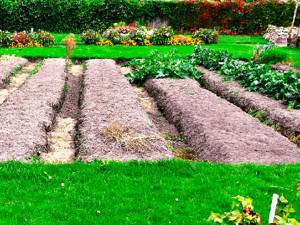
In the photo: Bulk beds
Raised beds have the following advantages:
- they warm up quickly in the spring, which allows crops to be planted earlier;
- the soil temperature in such beds is always higher, so heat-loving crops can be grown on them;
- the garden bed is set up quickly and is suitable for any vegetables, except moisture-loving cabbage;
- in low-lying areas with regular flooding, high beds are the only way to grow useful plants;
- It is easier to increase soil fertility in high beds.
Bulk beds also have disadvantages: the high cost of imported soil, as well as the rapid drying of the soil in the heat and, therefore, the need for frequent watering. This problem is solved by mulching the surface, but this also requires additional labor and financial costs.
- Cucumbers: why they dry in the greenhouse and in the garden
If there is no border, when it rains, water drains from the beds and the soil is washed away.
Box-bed
Having improved the bulk bed, a box is obtained. This is the name of a crop planting fenced with a border. It is not difficult to create a box, but you will need material for its fencing - brick, stone, boards, slate, etc. Organic waste (branches, leaves, tops, humus) is placed at the bottom of the box. Fertile soil is poured onto the drainage layer. When fencing the bed with boards, slate or brick, moisture is retained better, since these materials are not so heated by the sun. The fence does not allow weeds to get inside, and there are fewer of them. It is convenient to work with such beds, and if you constantly loosen the soil, then autumn digging may not be necessary. High-quality beds look good and elegant.
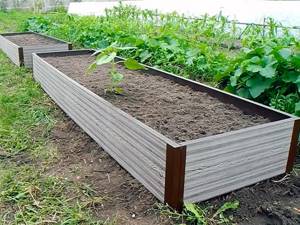
In the photo: Box bed
How to make a smart garden bed?
To make such a bed, you need to make a frame with high sides. The beds are filled not with ordinary soil, but with a specific one suitable for a specific crop, which consists of organic compounds, fertilizers, compost and soil.
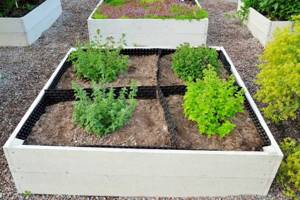
Warm beds. Such beds can replace greenhouses and produce an early harvest. But they need to be prepared in the fall.
We recommend watching
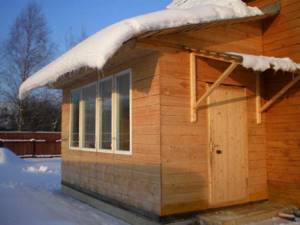
How to make an extension to a wooden house - step-by-step instructions for designing and building an extension (105 photos and videos)

How to trim grapes - detailed instructions for beginners, the procedure for performing the work and a step-by-step description of the pruning process (115 photos)

How to whitewash trees - 120 photos of whitewashing and tips on how to effectively whitewash fruit trees
Which beds to make at the dacha, high or low, smart or French, depends on the location of the garden and your desire.
What kind of bed should I make?
Why is it important to think carefully before choosing a bed shape for growing vegetables?
There are quite a few factors to consider:
- climatic conditions of the region (average daily temperatures, amount of precipitation and clear days),
- soil composition (for example, what predominates: loam or sand),
- proximity to water and much more.
Each of these points affects the moisture content in the soil and its nutritional properties, the rate of air exchange and the reproduction of beneficial microflora.
Only after carefully analyzing each factor can you decide whether to make the bed high or deepen it into the soil, wide or narrow, and what fillers to use for it. And this, naturally, will have a positive or negative impact on the yield, taste of vegetables and even the duration of their storage.
The bed must be warm
The construction of a bed for crops should begin with a natural heating device. Ideally, the bed should be level and well warmed by the sun's rays, i.e., oriented to the south.
- You should not make an excessively high or wide bed. The smaller it is, the more convenient it is to care for it, and the plants will receive more heat and moisture.
- The substrate should be moderately dense and quite loose - for example, cucumbers and others love this.
Reliable fences
Not very thick wooden boards can be used as fencing. They will avoid soil erosion, which can occur due to heavy rain or excessive watering.
For reliability, it is better to bury the boards 1/3 into the soil.
Fertilizer application
At the end of the summer season, it is advisable to add 300 g of wood ash, a bucket of humus and 1 tbsp. l. nitroammophoska per 1 m² of bed.
In order not to damage the insulation layer, you don’t have to dig up the soil in the garden bed. Simply lay the humus in a mound, sprinkle ash and nitroammophoska on top and distribute in an even layer.

DIY garden bed. Manufacturing procedure
Forming beds should begin in the spring, when the soil is sufficiently dry.
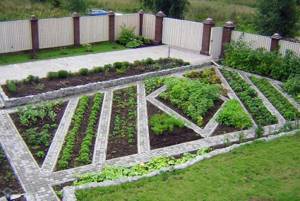
- Mark the perimeter of the future bed.
- Prepare all the necessary materials for the future fencing.
- When everything is ready, it’s time to start creating the structure.
- After assembling the fence, install it on the garden bed.
- It is necessary to lay out non-woven material at the bottom and fill in successively sawdust, leaves, and soil with fertilizer.
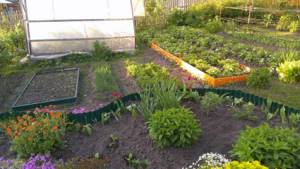
Your garden bed is ready for planting.
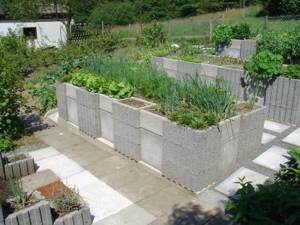
Making beds
How beautifully to decorate the beds at the dacha so that gardening brings not only a harvest, but also gives aesthetic pleasure. Below are tips on how to beautifully decorate your garden beds with your own hands.

In order not to invent fancy forms, you can borrow ideas from various printed publications or the Internet, which widely contain photos of beautiful garden beds.
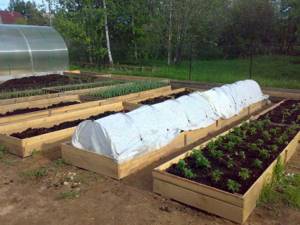
We recommend watching

What is the lunar landing calendar used for: features and rules for using the lunar calendar
- Ideas on how to make an ax - choosing a workpiece and a step-by-step description of the process of creating an ax with your own hands (110 photos and videos)
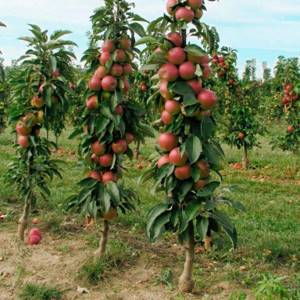
Proper planting of trees - ideas for proper planting and selection of placement plans in landscape design (80 photos)
If the dacha is intended for recreation, and a large number of beds are not planned, you can decorate the beds with lawn grass.
For original planting of plants and crops, combine different shapes and materials for fencing.
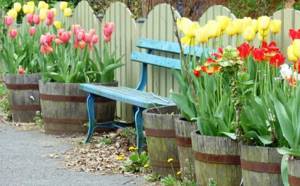
If the beds are located in the center of the plot, make them round and divide them into sectors with a sand embankment.

If the garden occupies a large area, then rectangular or square beds will look better.
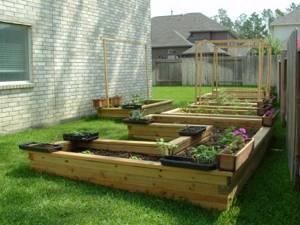
By taking a responsible approach to the location and design of the beds, you will, of course, achieve success in harvesting!

Neighborhood of garden crops
When planning the planting of garden crops, it is very important to distribute the plants so that they do not have a negative impact on each other. In addition, “predecessors”, that is, plants that grew on the site before, are of great importance. Gardeners have rules for planting garden crops based on the compatibility of plants and the choice of planting site based on what was grown in that area last season.
To determine the possibility of mixed planting, a table of the proximity of vegetables in beds is used, which indicates compatibility and recommended predecessors for many garden crops.
If you follow the rules for growing plants in one bed, you can plant several garden crops that will not only not interfere with each other, but also promote mutual growth. For example, a spice bed at the dacha can successfully combine 13 plants: fennel, rosemary, lemon balm, thyme, lofant, oregano, marjoram, sage, snakehead, savory, lavender, hyssop, Dubrovnik.
Combinations of a successful neighborhood in the garden:
- Bush beans. Pairs with: potatoes, cucumbers, corn, strawberries and celery. Doesn't go well with: onions.
- Headed. Pair with: spinach, potatoes, onions, lettuce, cucumbers, celery, beets. Do not combine: strawberries, beans, tomatoes.
- Carrot. Pairs with: tomatoes, sage, onions, rosemary, lettuce, beans. Doesn't go well: dill.
- Celery. Pairs with: beans, tomatoes, cabbage, onions. Not compatible: no.
- Corn. Pairs with: cucumbers, pumpkin, peas, beans, potatoes. Don't go together: tomatoes.
- Cucumbers. Pairs with: beans, corn, peas. Do not combine: potatoes, aromatic herbs.
- Lettuce. Combines: carrots, strawberries, cucumbers. Not compatible: no.
- Onion. Combines: beets, carrots, lettuce, cabbage. Do not go together: beans, peas.
- Peas. Combines: carrots, turnips, cucumbers, corn, beans. Do not combine: onions, potatoes.
- Potato. Combines: cabbage, corn, beans. Do not combine: cucumbers, tomatoes, pumpkin.
DIY photo of beds at the dacha
Did you like the article? Share


0
